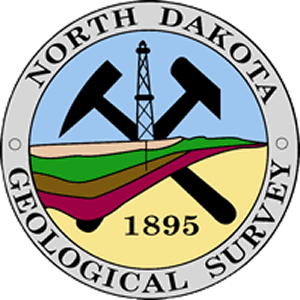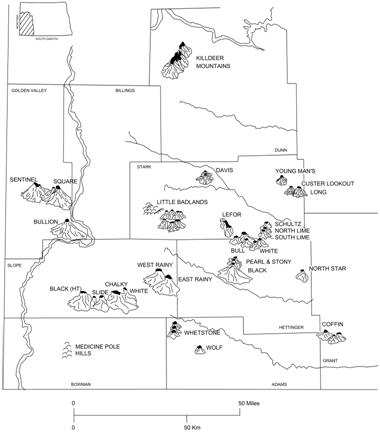

The three landforms marked by Xs in competition #13 are known collectively as Coffin Buttes. Located about 12 miles south of the town of New Leipzig in Grant County they are
clearly visible on the eastern horizon from State Highway 49 (fig. 1).
The upper slopes of Coffin Buttes comprise sediments of the Tertiary-age White River Group (Chadron and Brule Formations), and the Arikaree Formation. Fossil vertebrates, mostly mammals,
occur in all three formations particularly in the Brule, but with the exception of a few fragments tentatively identified as rhinoceros none have been found at Coffin Buttes. However, of the more than
140 fossil vertebrate taxa found at similar localities in western North Dakota at least 120 are mammals.
Buttes are the erosional remnants of former land surfaces. The buttes in southwestern North Dakota are the scattered remains of an Eocene/Oligocene/Miocene landscape that was formed between about 40 and 10 million years ago.
At this time, western North Dakota was undergoing a profound climate change due, in part, to regional uplift associated with the rising Rocky Mountains to the west and the Black Hills to the south. Contributing to this
change was a slowly deteriorating global climate, with glaciers already beginning to form in Antarctica: harbingers of the great ice age still more than 7 million years in the future. By the late Eocene western North Dakota
was a very different place to the subtropical world it had been for so long. Gone were the Cretaceous seas and the steaming coal swamps of the Paleocene. In their place was open woodland which, as the climate continued to
cool and dry, gradually gave way to an almost treeless savannah.

Figure 2. Buttes containing White River and/or Arikaree strata in southwestern North Dakota
This rather featureless landscape was dotted with lakes and crossed by sediment-laden rivers flowing out of the ancestral Rockies and Black Hills. Over a period of about 30 million years these sediments were
deposited as the sands, gravels, silts, and muds of the Chadron, Brule, and Arikaree Formations. At times their deposition was interrupted by ash falls from erupting volcanoes in what are now parts Wyoming and Montana.
By about 10 million years ago this pile of stream and volcanic sediment was more than 650 feet thick. Then, between 5 and 10 million years ago a major cycle of erosion began, which removed almost all of this material leaving,
in North Dakota, only isolated remains on the tops of a scattering of buttes in its southwestern corner (fig. 2).
An astonishingly rich assortment of fossils has been preserved in the rocks of the Chadron, Brule and Arikaree Formations: a silent testament to the diversity of fauna that lived on
North Dakota’s Tertiary savannahs. Vertebrate fossils, including mammals, are particularly abundant, especially in the lower portion of the Brule Formation. Many of these animals were members of
families that still exist today. Herds of Mesohippus, ancestral horses about the size of a greyhound, shared the grasslands with the forerunners of other mammals including dogs (Hesperocyon), rabbits (Palaeolagus),
squirrels (Ischyromys), sheep (Merycoidodon), pigs (Perchoerus and Archaeotherium), camels (Poebrotherium), and rhinoceros (Hyracodon, Subhracodon, and the gigantic Brontotherium). The lakes and streams were
populated by a variety of fish, amphibians, turtles, and several invertebrate species including snails and ostracodes. Giant tortoises, some as large as those found on the modern Galapagos Islands, roamed the
riverbanks and while their fossil remains are rare, there were birds as well to complete the tableau.
Returning to Coffin Buttes and the 21st century one might wonder how they came by their gloomy moniker. Local historian and long-time Grant County resident Roger Harmon very
kindly agreed to research this little mystery for me. The popular opinion appears to be that they were named for their shape, which was said to resemble a coffin or coffins. A glance at
figure 1 and aerial photographs of the buttes, however, soon dispels this notion. In my most recent conversation with Mr Harmon he informed me that he had visited with an elderly lady near
New Leipzig who told him that the buttes were named after a bachelor named Coffin who used to live in the area. Although county records cannot confirm this, a 1917 copy of the Morton and
Grant County Directory does include an entry for Otto E. Coffman who lived near Fleak, about 5 miles north of the buttes. The legal description of his property actually suggests that Mr. Coffman
lived some seven miles south of Fleak and within about two miles of the southernmost butte. Near, of course, is a relative term and in the wide open spaces of southwestern North Dakota it seems to
me that “near” could easily mean several miles. It may be, then, that Mr. Coffin and Mr. Coffman were one and the same but whether or not that is the case I think the eponym fits.
My grateful thanks to Mr. Harmon for all his hard work and entertaining conversations on the subject.
Administrative Assistant Linda Johnson drew Bill Kirk and John Mrozla as the competition winners. Both winners will receive a copy of Dinosaurs, Sharks, and Woolly Mammoths.
Congratulations to the winners, honorable mentions to all the folks who gave the right answer, and thanks to everyone who participated in the competition.
| Ron Bosch - Wheatland, WY | Alan Castoreno - Grand Forks |
| Bob Christensen - Bismarck | Ken Gardner - Drayton |
| Bill Kirk - Beulah | John Mrozla - Harwood |
| Terrance Zich - Sanford, FL |